
Europe - c1412 France - Boucicaut Master Illuminated Book of Hours, originally uploaded by jondresner.
Ciborium of Maître Alpais, Limoges, gilded copper with champlevé enamel, glass cabochons, ca 1200
Ciboire du Maître Alpais, Limoges, émail champlevé sur cuivre doré, cabochons de verre
Madonna and Child
Sassoferrato
Giovanni Battista Salvi, called
(Sassoferrato 1605 - Rome 1685)
Madonna and Child, circa 1650
oil on canvas
Giovan Battista Salvi known, from his town of origin in the Marche, as Sassoferrato, shows the Madonna seated on the clouds with her feet resting on the half moon. She embraces the Child Jesus who holds in his hands a rosary that ends in a rose. Heads of cherubs rise from the clouds. The image confirms the stylistic elements that characterize his vast production of subjects of a religious nature: images of a solid formal layout with brilliant and almost enamelled colours.
Schongauer played an important role in the development of engraving in the latter half of the fifteenth century. This image of a censer- a container used to burn incense during mass- is one of the most celebrated prints he produced, not least for the precision of detail the work displays. Schongauer gave the object a degree of physical presence and illusionism entirely new to engraving of this period. It is likely that the print reproduced an existing object, though it may also have been executed as a model for goldsmiths.
Text excerpted from the Metropolitan Museum of Art label.

German architect, painter, and designer, active mainly in Berlin. Schinkel was the greatest German architect of the 19th century, but until 1815, when he gained a senior appointment in the Public Works Department of Prussia (from which position he effectively redesigned Berlin), he worked mainly as a painter and stage designer. His paintings are highly Romantic landscapes somewhat in the spirit of Friedrich, although more anecdotal in detail (Gothic Cathedral by a River, Staatliche Museen, Berlin, 1813-14). He continued working as a stage designer until the 1830s, and in this field ranks among the greatest artists of his period. His most famous designs were for Mozart's The Magic Flute (1815), in which he combined the clarity and logic of his architectural style with a feeling of mystery and fantasy.
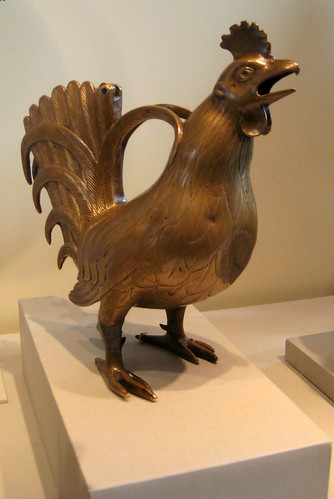
Aquamanile in the Form of a Cock
Copper alloy
Germany, Lower Saxony, 13th century
The Cloisters Collection, 1989 (1989.292)
Former owner: Walter Randall, Paris and New York
Aquamanilia, from the Latin words meaning "water" (aqua) and "hands" (manus), were animal- or human-shaped water vessels used to pour water over the hands of priests before celebrating Mass and of diners at meals, usually cast in copper alloy through lost-wax process.
Aquamanilia in the form of roosters are rare, but this one can be related to two other examples, all strikingly naturalistic, with densely engraved feather patterns over much of their surfaces. Only in this example, however, was the modeler bold enough to balance the bird on its feet. In other examples, the tail feathers were extended to create a tripod for greater stability.
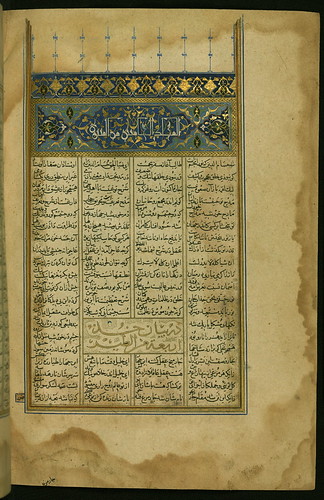
Floral and foliate decoration in gold. Leaf from an elegantly calligraphed and illuminated copy of the collection of poems, known as Mas̱navī-i maʿnavī, by Jalāl al-Dīn Rūmī (d.672 AH / 1273 CE). This codex was penned by Aḥmad ibn Ḥājjī Abī Bakr al-Kātib in 865 AH / 1461 CE.
See this manuscript page by page at the Walters Art Museum website:
art.thewalters.org/viewwoa.aspx?id=22125
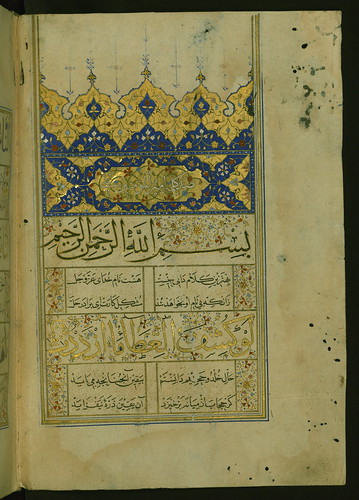
This beautifully illuminated manuscript contains One hundred sayings, known in Arabic as Mi’at kalimah and in Persian as Ṣad kalimah, attribted to of ʿAlī ibn Abī Ṭālib, the fourth caliph of Islam, as well as a Persian paraphrase (dubayt) by Rashīd al-Dīn Muḥammad al-Balkhī, known as al-Waṭwāṭ (Vaṭvāṭ) (d. ca. 578 AH / 1182 CE). This polychrome text, using a number of scripts, was executed by an anonymous artist most probably in the 9th AH / 15th century.
See this manuscript page by page at the Walters Art Museum website:
art.thewalters.org/viewwoa.aspx?id=5052
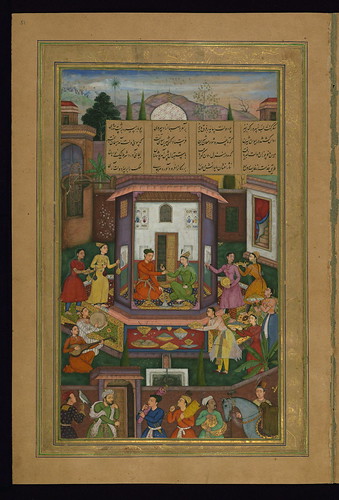
This is a deluxe copy of the Quintet (Khamsah) of Amīr Khusraw Dihlavī (d.725 AH /1325 CE). Although now incomplete, this manuscript was penned in nastaʿlīq script by the famous late 16th century Mughal calligrapher Muḥammad Ḥusayn Zarrīn Qalam al-Kashmīrī and decorated by a number of illuminators and painters. Its illustrations are signed by eleven painters: Laʿl (Lāl), Manūhar, Sānwalah, Farrukh, Alīqulī, Dharamdās, Narsing, Jagannāth, Miskīnā, Mukund, and Sūrdās Gujarātī. On the other hand, its headpieces and a medallion are inscribed with the names of Ḥusayn Naqqāsh, Manṣūr Naqqāsh, Khvājah Jān Shīrāzī, and Luṭf Allāh Muẕahhib. The codex has beautifully decorated borders with vegetal, bird, animal motifs and human figures. The figures are portrayed in various traditional activities such as praying, reading and hunting. Shīrīn entertains Khusraw.
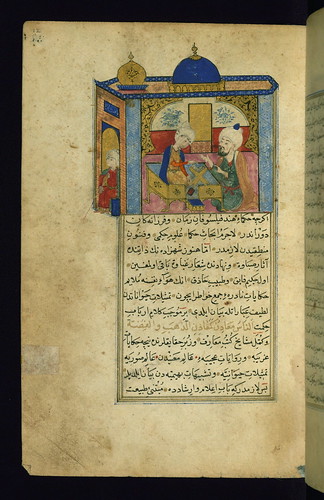
Tuḥfet ül-aḫyār. Folio from an Ottoman Turkish version of the well-known story of Sindbad (Sindbādnāmah) made from the Persian by ʿAbdülkerīm bin Muḥammed during the reign of Sultan Sulayman (Soliman) (reg.926 AH / 1520 CE - 974 AH / 1566 CE) and entitled Tuḥfet ül-aḫyār. This anonymous copy contains six illustrations made in the 10th century AH /16th CE.
See this manuscript page by page at the Walters Art Museum website:
art.thewalters.org/viewwoa.aspx?id=35391

A mufti, having heard a complaint from a mother about her son-in-law’s inability to consummate his marriage to her daughter, giving sexual advice. Leaf from an illustrated copy of the five poems (quintet, Ḫamse) of the Ottoman Turkish author ʿAṭāʾullāh bin Yaḥyá ʿAṭāʾī (d.1044 AH / 1634 CE). Copied in 1133 AH / 1721 CE this rare codex contains 38 miniatures.
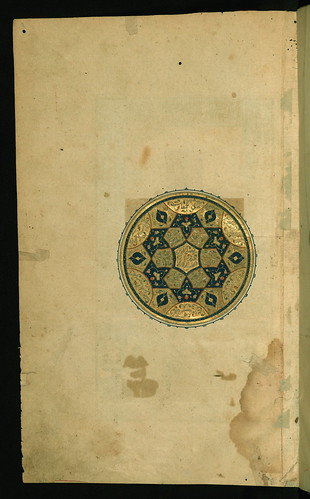
An illuminated and illustrated copy of the collected works of Sa`di (d.691/1292) (Kullīyāt-i Saʿdī) containing, among others, his Gulistān and Bustān. The present manuscript was penned by an anonymous calligrapher in Shiraz (Iran) in 934 AH / 1527 CE. Illuminated medallion with table of contents.
See this manuscript page by page at the Walters Art Museum website:
art.thewalters.org/viewwoa.aspx?id=22469
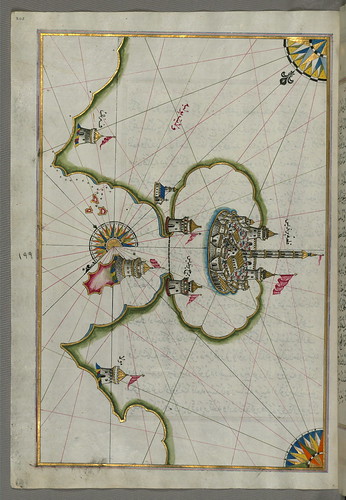
Originally composed in 932 AH / 1525 CE and dedicated to Sultan Süleyman I ("The Magnificent"), this great work by Piri Reis (d. 962 AH / 1555 CE) on navigation was later revised and expanded. The present manuscript, made mostly in the late 11th AH / 17th CE century, is based on the later expanded version with some 240 exquisitely executed maps and portolan charts. They include a world map (fol.41a) with the outline of the Americas, as well as coastlines (bays, capes, peninsulas), islands, mountains and cities of the Mediterranean basin and the Black Sea. The work starts with the description of the coastline of Anatolia and the islands of the Aegean Sea, the Peloponnese peninsula and eastern and western coasts of the Adriatic Sea. It then proceeds to describe the western shores of Italy, southern France, Spain, North Africa, Palestine, Israel, Lebanon, Syria, western Anatolia, various islands north of Crete, Sea of Marmara, Bosporus and the Black Sea. It ends with a map of the shores of the the Caspian Sea.
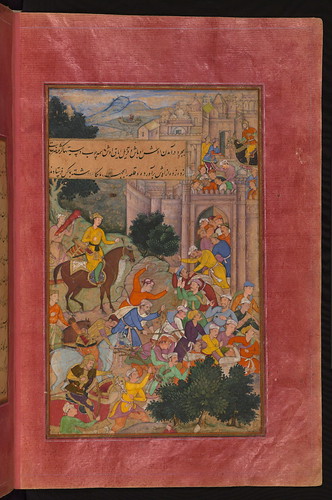
Written originally in Chaghatay Turkish and later translated into Persian, Bāburnāmah is the story of a Timurid ruler of Fergana (Central Asia), Ẓahīr al-Dīn Muḥammad Bābur (866 AH /1483 CE - 937 AH / 1530 CE), who conquered northern India and established the Mughal Empire. The present codex, being a fragment of a dispersed copy, was executed most probably in the late 10th AH /16th CE century. It contains 30 mostly full-page miniatures in fine Mughal style by at least two different artists. Another major fragment of this work (57 folios) is in the State Museum of Eastern Cultures, Moscow.
See this manuscript page by page at the Walters Art Museum website:
art.thewalters.org/viewwoa.aspx?id=1759
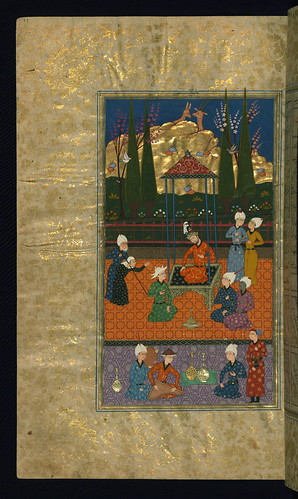
This is an illustrated copy of four of the five poems that comprise the Khamsah of Niẓāmī Ganjavī (d.605 AH / 1209 CE). It does not include Laylá va Majnūn. The text was copied by a certain Yādkār the Calligrapher (al-Kātib) in 935 AH / 1529 CE, most probably in Safavid Iran. An illuminated double-page composition opens the manuscript and each poem is initiated with a decorative headpiece. The miniatures appear to have been repainted at some point in the manuscript’s history. Their date and provenance are open to question. The textblock is bound in late Zand lacquer covers with scenes depicting Bahrām Gūr hunting and Khusraw watching Shīrīn bathing. An old woman approaches the throne of Sultan Sanjar to tell of her oppression.
See this manuscript page by page at the Walters Art Museum website:
art.thewalters.org/viewwoa.aspx?id=17718This is an illustrated copy of four of the five poems that comprise the Khamsah of Niẓāmī Ganjavī (d.605 AH / 1209 CE). It does not include Laylá va Majnūn. The text was copied by a certain Yādkār the Calligrapher (al-Kātib) in 935 AH / 1529 CE, most probably in Safavid Iran. An illuminated double-page composition opens the manuscript and each poem is initiated with a decorative headpiece. The miniatures appear to have been repainted at some point in the manuscript’s history. Their date and provenance are open to question. The textblock is bound in late Zand lacquer covers with scenes depicting Bahrām Gūr hunting and Khusraw watching Shīrīn bathing. An old woman approaches the throne of Sultan Sanjar to tell of her oppression.
See this manuscript page by page at the Walters Art Museum website:
art.thewalters.org/viewwoa.aspx?id=17718

An elegant copy of the "Quintet" (Khamsah) of Niẓāmī Ganjavī (d.605 AH / 1209 CE) penned by Abū Bakr Shāh ibn Ḥasan ibn ʿAlī al-Shahrastānī and illuminated by Jamāl al-Dīn ibn Muḥammad al-Ṣiddīqī al-Iṣfahānī between 892 AH / 1486 CE and 900 AH / 1494-05 CE. The present codex, opening with a double-page decoration and the inscription giving the name of the author and the title of the work,contains four additional illuminated headpieces with the names of the individual books and 26 repainted miniatures. The page depicts Manūn visiting his father’s tomb.
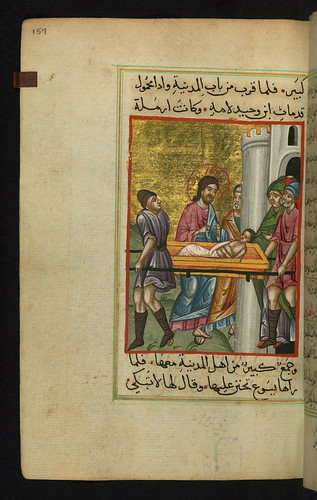
This illuminated and illustrated Arabic manuscript of the Gospels by Matthew (Mattá), Mark (Marquṣ), Luke (Lūqā), and John (Yūḥannā) was copied in Egypt by Ilyās Bāsim Khūrī Bazzī Rāhib, who was most likely a Coptic monk, in Anno Mundi 7192 / 1684 CE. The text is written in naskh in black ink with rubrics in red. Jesus raises a widow’s son at Nain.